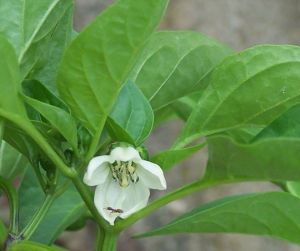
I’ll be the first to admit it… I’m a tinkerer. I can’t just leave well enough alone- whether it’s a recipe (even when I know it’s good!) or gardening, I always have to try a little something new. Now that we’re getting our outdoor space settled and organized, there is some work (really, actually fun) to do! We were fortunate to get a lot of space for our yard, so there is plenty of room to experiment.
Last year, we put in our new garden and did a lot of yard adjustments. While we did and will continue to fight the weeds back (organically) for the near future, I could no longer deny the glossy pages of the seed catalogs that beckoned with spring-y seductiveness all winter. And don’t get me wrong, I buy local also, with the occasional detour for items that are fairly unique offerings. Unfortunately, not everything is grown organic, but I figure that by doing things as organically as we can, we can mitigate that part somewhat.
Here are some of the new vegetables and plants we’re trying this year… More to come on the results!
Hops
I’ve started homebrewing, so a combination of a steady future supply of this essential ingredient and an abundance of fences make hops bines a perfect yard addition. I’ve bought some locally and at beer fests, and I’ve seen collections in catalogs, but The Wine and Hop Shop had the most options and good quality, also. (I think I have a few more varieties… and some wine grapes… in my future.)
Strawberries
Strawberry, Tristan (We liked the color of the flowers; they’re different! And… strawberries.)
Pineberry, White Carolina (Strawberries that taste like pineapple? And we’re in a zone that can grow them? Sign me up.)
Yellow Wonder Wild Strawberry (Another strawberry- another flavor.)
Attila Strawberry (I’m a fan of the productivity and flavor of alpine strawberries. And these have runners!)
White Soul Alpine Strawberry (Strawberries… gotta collect them all!)
Vegetables
Potato, Blue (These are just plain interesting. Several catalogs have them, but I haven’t seen them in stores yet. The story partially behind purchasing them is that my father and grandfather would argue over whether white or red potatoes, respectively, were better. I guess I’m obligated to like blue ones best!)
BEIRA TRONCHUDA PKT (Maybe not a true kale, so my wife will be extra disappointed…not really.)
Scarlet Runner Bean (The color of these, flowers and seeds, is just awesome.)
ORACH PURPLE PKT (I can’t say I’ve ever had a salty leafy vegetable, but it will be a nice contrast in the garden and should be a healthy add-in to salads.)
‘Strawberry Spinach’ (Neither strawberries nor spinach- it should be good for salad.)
Santon Charentais Melon (I am a fan of melon varieties, especially the non-standard/rare ones.)
Tigger Asian Melon (These will stand out in the garden for sure.)
Petit Gris de Rennes Melon (The melons I bought are all open-pollinated, so they will grow true from saving seeds- versus hybrids.)
Long Island Cheese Pumpkins (These are a recommended variety to use for pies. I also like to make pumpkin risotto or pumpkin soup.)
Herbs
Shiso Green Perilla Aoshiso (I have red shiso/perilla. It’s extremely easy to grow from seed and makes an attractive contrast plant with the leaves and flowers. It has a wonderful aroma and appealing basil-like oil to the leaves and can be used as an herb for cooking. Just be careful when it gets close to seeding or you may end up with them everywhere. It didn’t do too poorly in a pot last year as long as I kept it watered.)
Garden Sorrel (It’s perennial, and can be used in salad.)
Grain/Seeds
Quinoa, Brightest Brilliant (Quinoa is not just trendy; it is truly healthy!)
India Red Popping Sorghum (I thought this might be an alternative to growing popcorn along with sweet corn. We’ll see how this grows and how it tastes.)
Emmer Wheat (Since I’m getting into brewing, it looked intriguing. The note about the old variety sometimes being more palatable for those with gluten issues piqued my interest.)
Et Cetera
Passion Flower, Maypop (We think it has neat-looking flowers, and I’m a fan of anything edible- maximizing use and utility of space. Oh, yes, and we still have lots of fences for vines.)
Lilac, Dwarf Josee Reblooming (My wife adores lilacs; this one blooms for quite a while.)
Luffa Sponge, Packet (I thought we’d give these a try to see if we could grow some sponges. The biggest challenge will be the time to maturity.)
PEANUT JUMBO VIRGINIA (This is another item that might be a plant maturity stretch, but I’m willing to give it a go. Not many catalogs had peanuts for sale. The flowers are a nice accent in the garden.)
SILVER BELLS TM CHOCOLATE VINE
VIOLET CHOCOLATE VINE (Not actually chocolate… they just smell like it! The seed pods are tasty too! At least one of each vine is needed.)
Apios Americana “Potato Bean/Groundnut” (I’m still debating on which vendor I will use to get this, as it’s not offered in many catalogs I can find. I discovered it via the linked blog. This flowering native plant with edible parts looks well worthy of growing. Ahem… fences.)
Sunberry/Wonderberry (An interesting find… appears to be an annual.)
Trees
Fir, Korean (Blue pine cones! Blue pine cones!)
Redwood, Dawn (I was intrigued partly that this is an ‘older’ type of tree. Not too long ago, I read that it was somewhat recently fairly rare.)
Phew! It’s a lot of seeds and plants, but time and the season will tell what the garden and yard may provide. As you may have noticed, I’m a fan of the rare and/or different. And don’t worry, we’re still growing the classics, too. What new plants are you trying this year?















